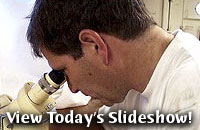 Print
page Print
page Email
to friend Email
to friend


TODAY'S WEATHER
Sunny
69°F (20.6°C)
Latitude:
00 deg 5.2'N
Longitude: 91 deg 48’W
Wind Direction: SSW
Wind Speed: 14 Knots
Sea State 3
Swell(s) Height: 2-4 Foot
Sea Temperature: 63°F (17.2°C)
Barometric Pressure: 1012.0 MB
Visibility: 12 Nautical Miles

Breakfast
Fresh fruits
Yogurt
Banana nut muffins
Steak and eggs
Potatoes
Bacon, ham and sausage
Pancakes
Oatmeal
(Dried cereal is always available in the pantry)
OJ in a bucket
Lunch
Fresh salad
Philly cheese-steak
Cream of mushroom soup
French fries
Ice cream sandwiches
Dinner
Fresh salad
Chicken Kum Po
Fried rice
Egg rolls
Stir-fried vegetables
Fresh bread
Blueberry Pie
Celestial Navigation
September 3, 2001
by Joseph Ferris and Christina Reed
At
sunrise, during the day or at dusk, when the division between
sea and sky is a distinct horizon, the Captain and Mates of
RV Revelle practice the traditional mariners’ art
of celestial navigation.
Standing outside of the bridge, away from their
electronic radar and Global Position System (GPS) they hold up
the ship’s sextant, a tool that measures the angle
of the Sun, Moon, planets or stars from the horizon. These celestial bodies help
determine our ship’s position at sea and can check the accuracy of our compasses.
“If
you look at three different stars and measure their distance
from the horizon, there is only one place in the world where
all the angles intersect,” says Eric Wakeman, the Chief
Mate. “And that's right where you’re at.”
During the day, as the sun passes overhead,
the Mates can also use the sextant to measure different angles
of the sun above the horizon. If they also know the accurate
time, these angles allow them to calculate their position.
“When we are not busy with dredging or other station operations, we take
pride in being able to do celestial navigation and get an accurate fix,” says
Captain Chris Curl.
Tonight, with blue whales feeding on krill
and Fernandina swallowing much of the southwestern horizon we
took a reading off of three stars: Arcturus, Spica and Dubhe,
which is the last star on the ladle of the Big Dipper. Sure enough,
the position we calculated from those sightings matched where
3 satellites in the GPS constellation have us plotted.
[Back to top]
|



